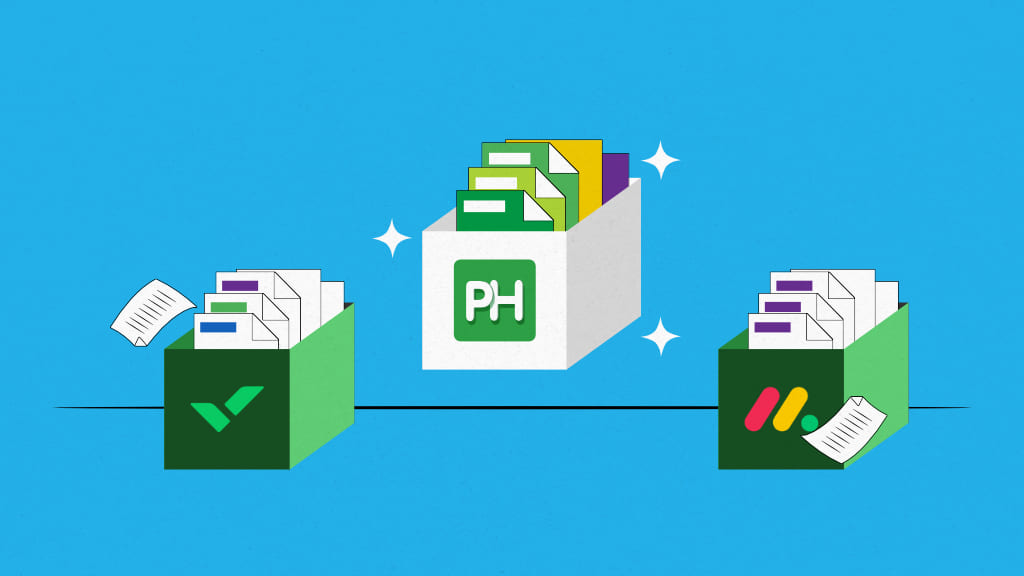In today’s rapidly advancing world businesses work on multiple projects and to add to this, there is a continuous flow of new project ideas. Project portfolio management software assists business owners and project leaders in organizing their files for easy and quick access.
With the help of portfolio management software, managers maintain a comprehensive overview of projects aligning most effectively with the organization’s requirements.
In this article, we will discuss various project portfolio management software, exploring their features, pros, cons, pricing, and ratings. Whether you belong to a small business trying to streamline processes or a large company aiming to optimize resources, our post provides a curated list of the best PPM tools.
What is a project portfolio management software?
A project portfolio management software organizes all your company’s projects in an organized way. This helps you in having complete control over the various projects in progress. Further, you can also monitor the projects in the pipeline stage, pre-planning stage, and the finished stage.
12 Best project portfolio management software of 2025
1. ProofHub
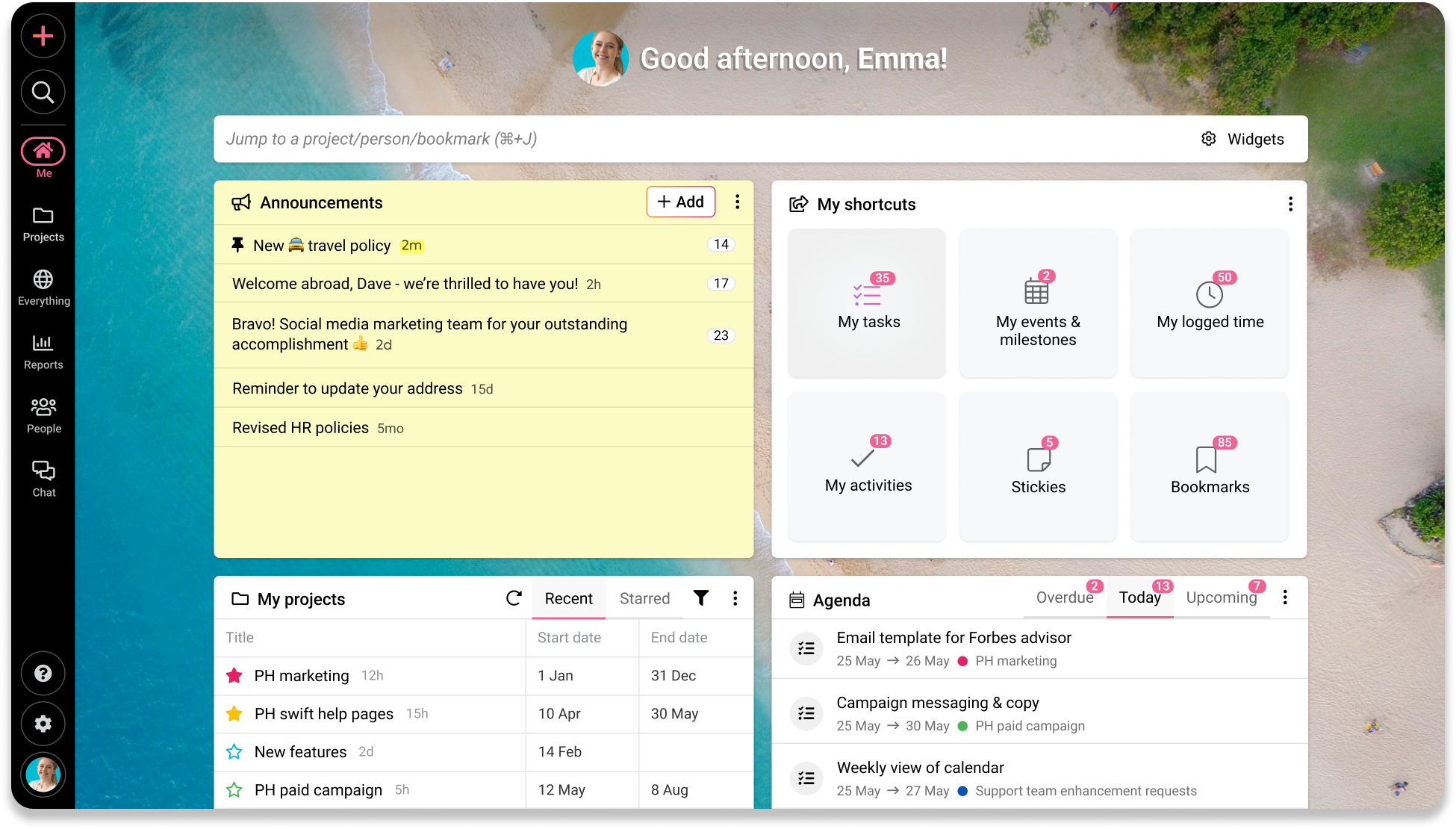
ProofHub is an all-in-one project management and team collaboration tool that serves as an intuitive dashboard for managing both upcoming projects and in-progress projects with ease. The task management dashboard serves as the centralized platform for managing workflow, resource allocations, and streamlining upcoming projects.
When it comes to Portfolio and project management software, you would want an all-in-one tool. And this is what exactly you get with ProofHub. You are able to schedule future task activities, forecast resources, optimize risk management, and complete projects within budget.
Key features
1. Centralized Collaboration: ProofHub provides a unified platform for seamless team collaboration. Bid farewell to scattered communication as all project-related discussions and updates are centralized.
2. Task and Project Planning: Managers can effortlessly plan tasks and projects with ProofHub. The intuitive interface ensures clarity in project goals and timelines, promoting better coordination among team members.
3. Time Tracking: Stay on top of project timelines with ProofHub’s time-tracking feature. Managers can monitor the hours invested in each task, promoting accountability and efficient resource utilization.
4. Gantt Charts for Visual Planning: Visualize project timelines and dependencies through interactive Gantt charts. This feature provides managers with a dynamic tool to plan, adjust, and communicate project progress effectively.
5. File Sharing and Document Management: Bid farewell to email attachments and scattered documents. ProofHub offers a centralized hub for sharing and managing project-related files, ensuring everyone has access to the latest resources.
6. Feedback and Proofing: Simplify the feedback loop with ProofHub’s dedicated features. you can streamline the review and approval process, reducing the time spent on revisions and enhancing overall project efficiency.
Pros
- Intuitive and user-friendly interface
- Comprehensive collaboration tools (Chat, discussions, announcements, Proofing & more)
- Efficient task and project management capabilities
- Visual planning with Gantt charts
- Effective time tracking for project monitoring
- Customizable workflows for typical project requirements
- With flat pricing, with no per-user fee.
- Effective and quick response from the customer support team
Cons
- Notifications are sometimes overwhelming.
- Does not create invoices for logged time (Covered via integration with Freshbooks & Quickbooks)
Pricing
ProofHub comes with no-per-use-fee plan. You can effectively add as many users as you want without any additional charges.
You can start with the 14-day free trial plan before moving to paid plans. The Essential plan starts from $45 per month (billed annually) for unlimited users and the Ultimate Control starts from $89 per month (billed annually) for unlimited users and projects.
Rating
Capterra rating: 4.6 out of 5 stars
G2 rating: 4.5 out of 5 stars
2. Planisware
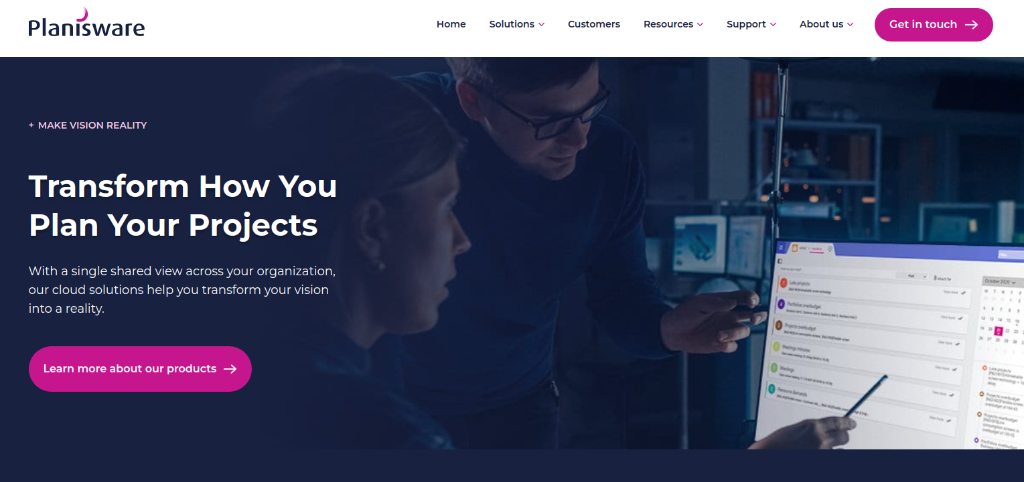
With Planisware, you can create a single pipeline for managing and analyzing all your upcoming projects. This tool has the scalability feature to grow and adapt to the growing demands as the business grows over time.
Further, with advanced pipeline management features, you can forecast, schedule, plan, and manage upcoming projects with ease. This helps in real-time planning and helps you to match expectations with reality.
Key features
- Analyse and cross-verify proposals with both qualitative and quantitative attributes.
- The intuitive dashboard helps you to identify potential bottlenecks that could arise because of labor shortages and helps you to take immediate steps to rectify them.
- Establish a clear forecast of the requirement of resources across the flow of the project and establish a seamless flow of the various tasks.
Pros
- Make logical and effective plans even for hypothetical situations
- Simple to use the place for managing all your upcoming projects.
- Customizable dashboard, with access to multiple integration options.
Cons
- The cost of deployment of the software is quite high
- There is a steep learning curve, and first-time users would get overwhelmed.
- The user interface is bulky and complex to use.
Pricing
Pricing details are not available on the website. You can contact their sales team for details about pricing.
Rating
Capterra rating: 4.1 out of 5 stars
G2 rating: 3.9 out of 5 stars
3. Zoho projects
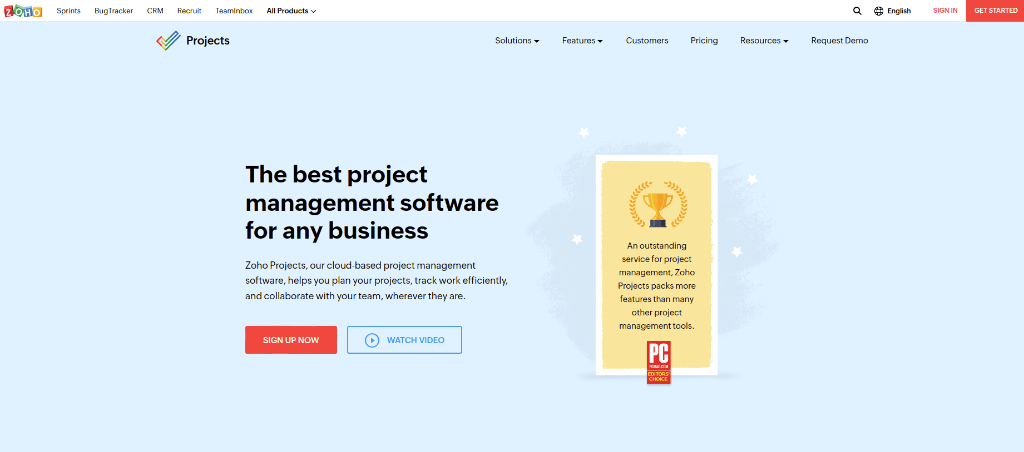
If you are looking for a tool that will help you to manage multiple projects simultaneously, Zoho projects come in for your aid. Multiple views in the form of Gantt charts and board views provide you with wide visibility of the various tools.
Additionally, with Zoho projects, you get access to the entire Zoho suite which includes Zoho financial suite, books, CRM, etc. Therefore, you can eventually stay in a single environment for all your management requirements.
Key features
- Notify project progression to your team members by setting up milestones, reminders, and notifications.
- Team members have a transparent view of the work order with the help of dependencies.
- The calendar ensures that you do not miss out on any task activity by filling up all cracks
Pros
- The drag-and-drop feature in Kanban boards makes it easy to change the stage of the tasks
- Forecast resources and projects schedule with confidence
- Manage the overall resource utilization of your team with ease
Cons
- The interface is not user-friendly
- The learning curve is steep
- Limited customization options
Pricing
The premium plan costs $4 per user per month, while the Enterprise plan costs $9 per user per month. The per-user charges may come in as a deterrent when the size of your team is large.
Rating
Capterra rating: 4.4 out of 5 stars
G2 rating: 4.3 out of 5 stars
4. Businessmap
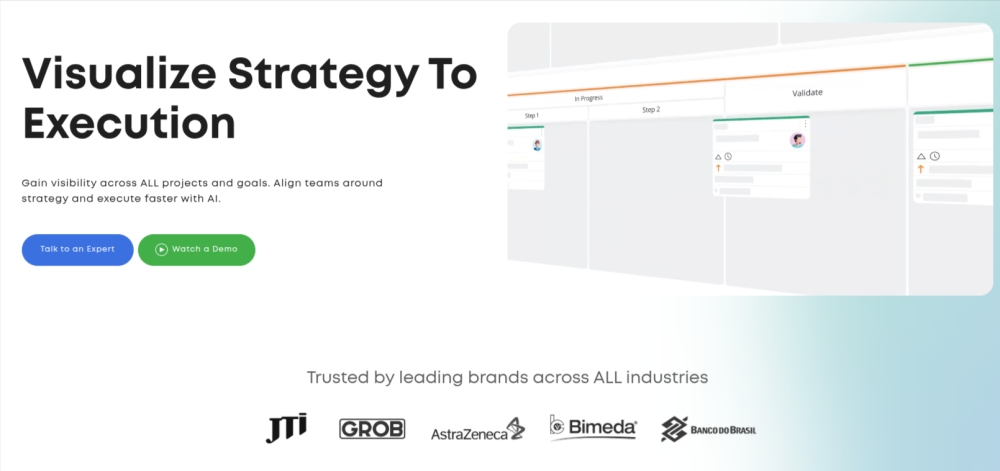
Closing the strategy-to-execution gap is no longer a challenge with Businessmap. This project and portfolio management platform enables organizations to align high-level goals with day-to-day operations, ensuring strategic priorities directly guide execution at every level.
With interactive AI-powered whiteboards, leaders can map and visualize strategic goals and seamlessly connect them to project portfolios. Customizable execution boards help teams coordinate cross-team initiatives, identify bottlenecks, and highlight priorities.
Key Features
- Built-in OKRs that link daily work to company objectives
- Executive dashboards to compare goal progress against work progress
- AI-powered tools to generate templates, comments, work analyses, summaries, tasks, and more.
Pros
- Flexible and adaptable, allowing for seamless customization to fit organizational needs and workflows.
- Regular updates that improve the platform over time.
- Highly responsive support team.
Cons
- Learning curve for advanced functions
- User interface can feel unintuitive at times.
- Pricing may not be the best fit for individual users.
Pricing
The Standard plans start from $9.9/user/month (annually) with no limitations on all features. Talk to sales for your custom enterprise plan (less than $7/user for 1000 users.)
Rating
Capterra: 4.8 out of 5 stars
G2: 3.9 out of 5 stars
5. Monday.com
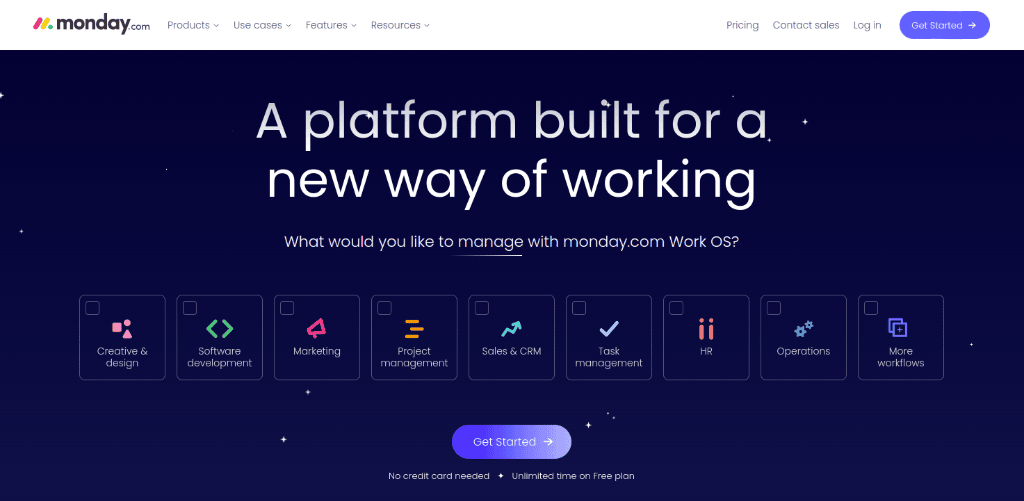
When you are looking for software that helps you create custom workflows as per the typical requirements of your team, Monday.com is your go-to portfolio management software.
Further Monday.com provides you with advanced automation facilities that help you to save time and improve the productivity of your team. However, Monday.com lacks when it comes to reporting functionalities, thereby, making it slightly difficult for managers to make decisions with confidence.
Key features
- Wide visibility helps you to have complete control over the flow of projects in your company.
- Helps you in keeping track of the time spent by your team members on various tasks.
- Different template options will assist you in creating a workflow for your typical project requirements.
Pros
- Transparent and wide view of the workflow and tasks of your team members.
- Quick and seamless integration for smooth and seamless flow of project
- Save time by streamlining processes and project workflows
Cons
- Certain features are available only in premium plans with additional charges.
- The customer support team is not efficient and does not solve queries quickly
- Exporting data is slightly complex
Pricing
The basic plan costs $9 per user per month, while the standard price costs $12 per user per month and the Pro plan costs $19 per user per month.
Rating
Capterra rating: 4.6 out of 5 stars
G2 rating: 4.7 out of 5 stars
6. ActiveCollab
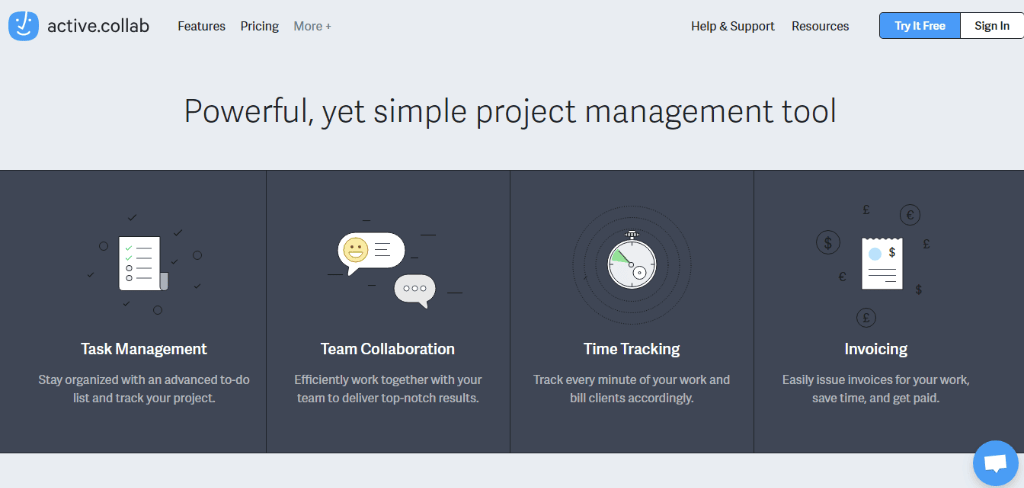
If you are looking for software that will help you in making plans and strategies for the smooth flow of your business. This is possible with the help of effective scheduling and a collaborative environment
With ActiveCollab you can always stay on top of your schedule with effective notifications and reminders for you to stay on top of your schedule. This eventually assists you in delivering high-quality projects.
Key features
- With different views, you can get an overall perspective of the workflow with ease
- Real-time feedback ensures that your team members stay updated and on the same page
- Helps you to sort tasks and activities as per importance for effectively completing projects within budget and time frame.
Pros
- Built-in time tracker for keeping track of the performance of team members.
- Templates for both workflows as well as projects
- Visually appealing dashboard with a unique user-friendly interface
Cons
- The software does not adapt to your growing team size and project
- Advanced reporting functions are available in premium plans
- Limited options for customizations
Pricing
The plus plan starts from $9.5 for 3 users per month, while the Pro plan costs $8 per user per month and Pro+Get Paid costs $11.75 per user per month.
Rating
Capterra rating: 4.5 out of 5 stars
G2 rating: 4.2 out of 5 stars
7. Planview
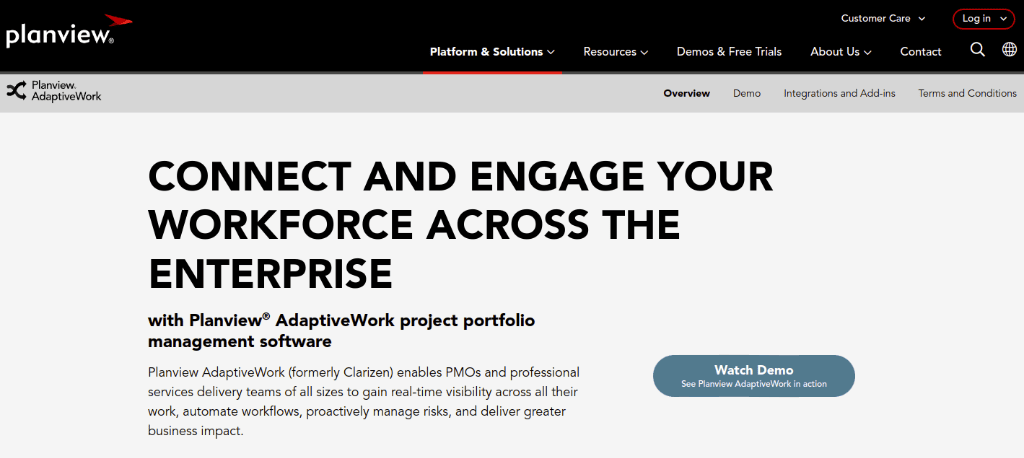
Planview is primarily best suited for capacity planning and creating strategies for managing projects. You can have a customized dashboard that lets you optimize the workflow as per your specific requirements.
Further, with this tool, you can make precise and accurate decisions because of the data-driven insights you get from the software. This helps you to remain aligned with the overall vision of the company.
Key features
- The automation feature helps you manage repetitive tasks and helps you save time and enhance productivity.
- With accurate tracking of progress, you can make effective decisions for the overall improvement of the company
- The software adapts to the growing necessities of the company.
Pros
- Quick onboarding and simple configuration
- User-friendly interface
- Customize the dashboard as per the individual requirements of your project
Cons
- The user interface is not friendly
- There is a learning curve
- Quite overwhelming for first-time users
Pricing
Plan details are not mentioned on the website. You can contact their sales team for pricing information.
Rating
Capterra rating: 3.9 out of 5 stars
G2 rating: 3.6 out of 5 stars
8. Bubble PPM
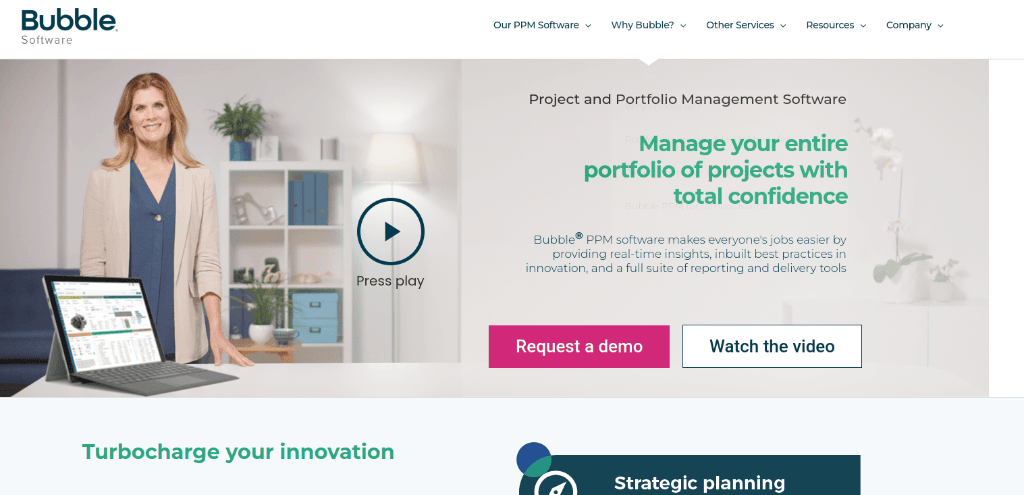
If you are looking for management software that provides you with advanced reporting features, Bubble PPM is your go-to choice. The tool lets you have complete control over the portfolio and the other details of your project.
Additionally, the software is highly configurable and provides a visually appealing interface that helps users to easily adapt to the software and work with ease.
Key features
- Sort various projects as per their importance and priorities.
- Maange what-if scenarios, alternate roadmaps, and workload views with different views and perspectives
- Seamless integration for efficient working and smooth workflow management
Pros
- Managing multiple projects and aspects with ease
- API integration for custom workflow
- Freedom and flexibility of working in different spaces
Cons
- The user interface requires improvements
- Scalability is limited
- Sudden change in pricing, making it costly – resulting in distraught users.
Pricing
Plan details are not available on the website. You can contact their sales team for pricing details.
Rating
Capterra rating: 4.6 out of 5 stars
G2 rating: 4.6 out of 5 stars
9. Oracle Primavera
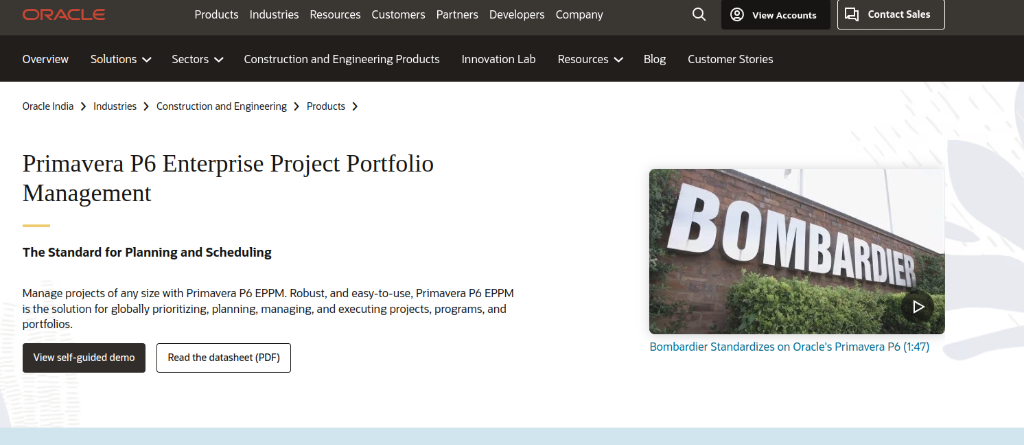
With Oracle Primavera, you can have your entire team working together, by bringing different team members together. This helps you to manage and deliver projects on time.
Additionally, you can use this tool for scheduling tasks as well as for risk management. This platform serves as the central repository for providing you with the necessary details for the seamless functioning of your projects.
Key features
- Provides a central platform for managing capital and budget planning
- Real-time insights for effective risk management
- Effective forecasting with planning and scheduling tasks for smooth project progression
Pros
- User-friendly interface
- Ability to serve multiple industries and aspects
- Quick onboarding
Cons
- Response from the customer support team is not effective
- Not suitable for small businesses as this software is designed for enterprise business
- Overwhelming for first-time users
Pricing
Plan details are not mentioned on the website. You can contact their sales team for pricing details.
Rating
Capterra rating: 4.4 out of 5 stars
G2 rating: 4.4 out of 5 stars
10. Celoxis
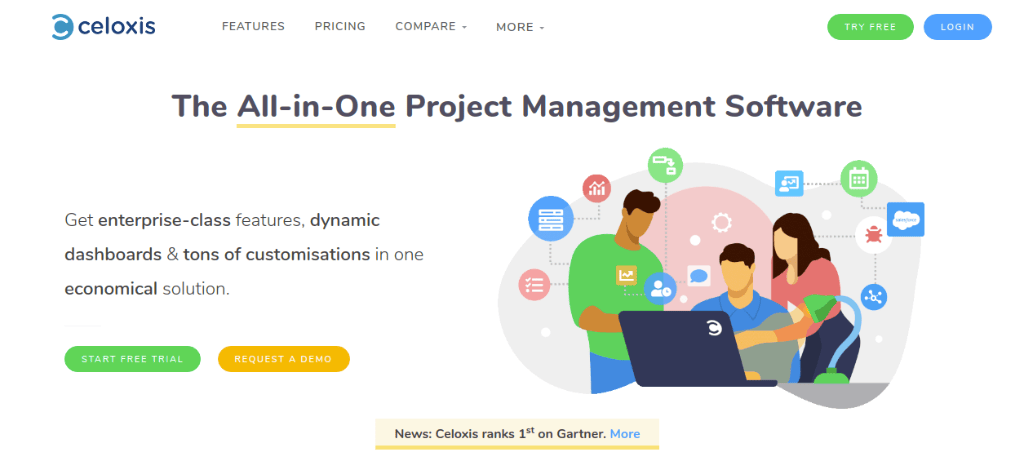
When it comes to managing resources for a project, having complete control over your team members is essential for the seamless flow of projects. With Gantt charts, you will be able to monitor workflow and workload distribution as well as ensure timely completion all in the same dashboard.
Additionally, you can optimize your project portfolio and track profit margins, you can use Celoxis for managing multiple aspects of the project on the central platform.
Key features
- Get an all-round view of the project progression with multiple wide views for different perspectives
- Allocate resources based on the existing workload for a smooth and even distribution of tasks.
- Transparency in tasks allows team members to collaborate and complete projects before deadlines.
Pros
- Built-in time tracker useful for invoicing and billing
- Customizable and intuitive dashboard
- Ensure even distribution of workload among your team members.
Cons
- Scheduling tasks is sometimes buggy
- Custom fields in reports are not available
- Roles and responsibilities are not defined properly
Pricing
The plan starts from $22.50 per user per month. This is a bit pricing, for a tool that is cloud-based.
Rating
Capterra rating: 4.4 out of 5 stars
G2 rating: 4.4 out of 5 stars
11. Wrike
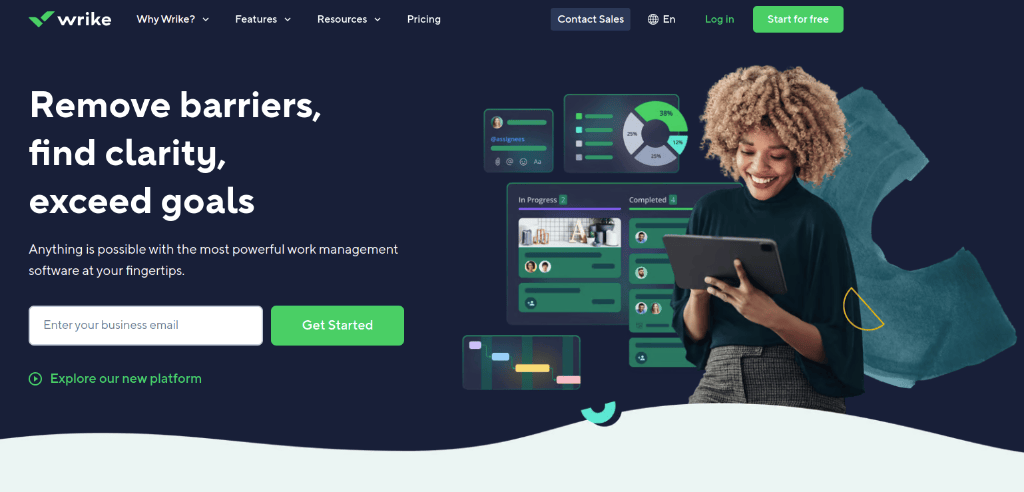
What sets Wrike apart from other tools is the innate ability to manage the workload of your team members. Further, the tool provides you with automation facilities that will help you to identify at-risk projects and solve issues on priority.
Additionally, the tool lets you switch seamlessly between different views and you have wide visibility over various project activities. This ensures that project activities do not fall into the cracks and that you cover all necessary conditions with full effect.
Key features
- Numerous templates and custom workflows help you to design your portfolio dashboard the way you want.
- By effectively defining the roles and responsibilities of various team members you can have complete control over who gets to access what.
- Different lanes for different projects make it easy for you to track the overall progress of the project
Pros
- Quick and effective response from the customer support team
- Efficient scalability features for the software to grow with your company
- Simple onboarding and user-friendly interface
Cons
- Although reporting is accurate, it gets a bit complicated at times.
- For access to complete and advanced functionalities, you need to subscribe to higher premium plans
- Lack of complete transparency in the processes.
Pricing
The Teams plan starts from $9.80 per user per month and the Business Plan starts from $24.80 per user per month. The per-user pricing makes this tool quite costly for large teams.
Rating
Capterra rating: 4.4 out of 5 stars
G2 rating: 4.2 out of 5 stars
12. Smartsheet
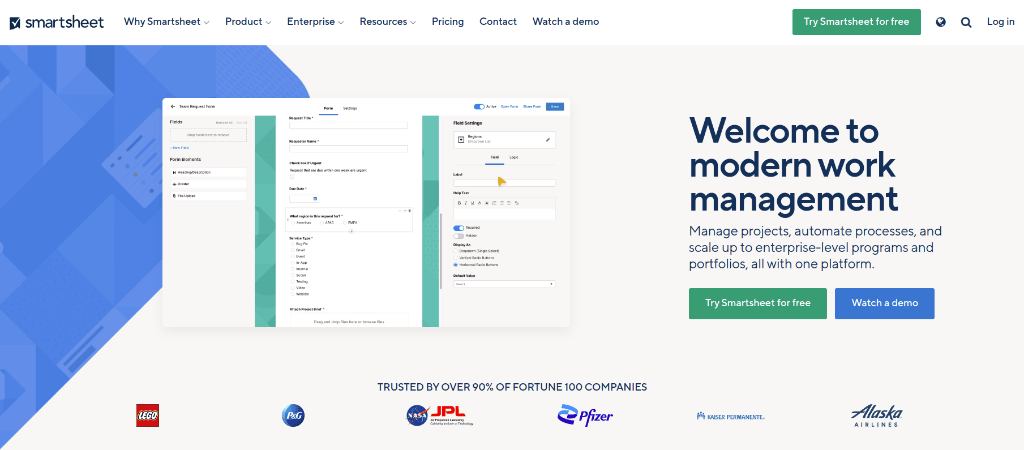
Although Smartsheet is in the 12th position, it does not mean this is the last ranked with the least usefulness. We found the reporting features of this software to be extraordinary, and that is the prime reason for this tool to make it to this list.
The reporting functionalities help you to effectively use the tool for managing the entire record of the software, i.e., you can effectively make data-driven decisions regarding forecasting and continuous growth.
Key features
- You can view real-time metrics for specific projects with the advanced customizable dashboard.
- Provides you with excellent control over your team and a quick overview of what your various team members are up to.
- Building workflows with quick and effective collaboration helps in efficiently completing projects on time.
Pros
- The automation makes it easy to complete tasks with ease.
- Wide visibility over various projects.
- Customized workflow helps you with enhancing overall productivity.
Cons
- There is a steep learning curve
- The customer support team is not efficient
- Templates should be easy to manage
Pricing
The Pro plan starts from $7 per user per month and the Business plan starts from $25 per user per month.
Rating
Capterra rating: 4.5 out of 5 stars
G2 rating: 4.4 out of 5 stars
How to choose the right project portfolio management software for your business?
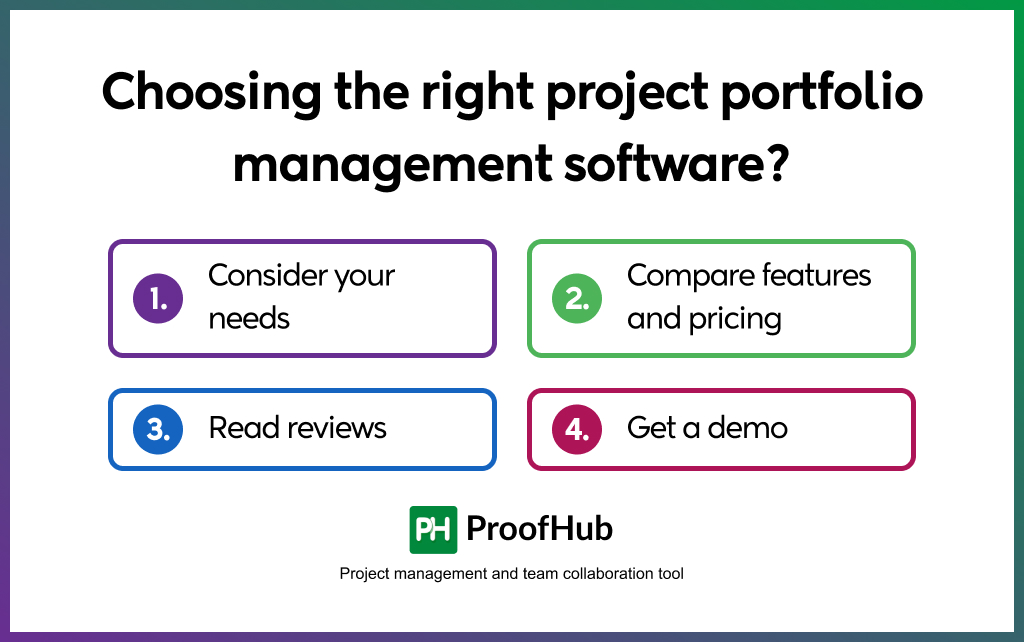
Let me just put out my few tips that will help you to choose the right portfolio project management software with confidence.
1. Consider your needs
Different businesses have different requirements. So you need to take up an effective call when it comes to choosing the right software for your company.
Always remember that the tool that your competitor is using will not be suitable for your business. So select a tool that provides you with features suitable for your business.
2. Compare features and pricing
The pricing of project portfolio management tools varies widely. It is therefore essential for you to fix a budget and then hunt for the tool. Take note that you need to compare prices with features in order to ensure that you select the right tool at the right price.
3. Read reviews
Trusted review websites like G2 and Captera provide you with real reviews of user ratings. Further, you can understand the performance of the various tools and the effectiveness of the customer support team from these websites.
4. Get a demo
Most tools provide you with a free trial for a limited duration. Use this time period to your advantage and explore the complete potential of the software. This will help you to decide on the usability of the tool in your company with confidence.
Why is PPM software important for businesses?
The role of project portfolio management software is to keep details and documents of various projects in an effectively organized manner.
PPM software serves as the central repository for storing all your project information and details – both past and upcoming- These tools for portfolio management are helpful for your business analysis in the following four aspects –
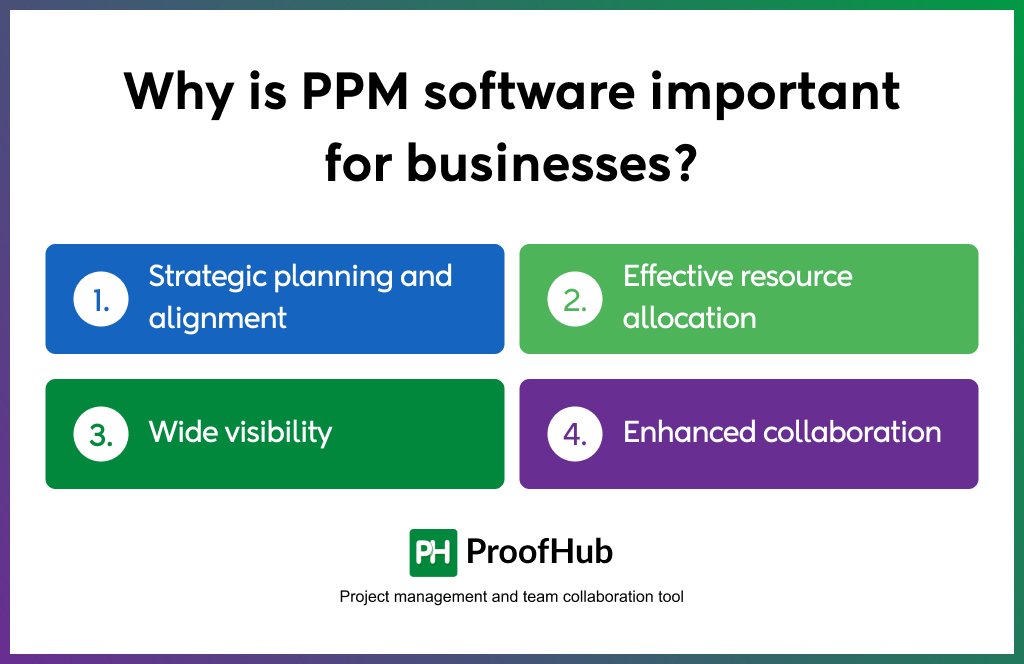
1. Strategic planning and alignment
PPM software helps you align projects with the company’s overall vision. The software helps you to plan future road maps for your project and identify resource shortages, conflicts in schedule, and budget overruns. This helps you to manage projects and make informed data-driven decisions.
2. Effective resource allocation
With PPM software you can effectively manage your resources for a smooth and steady progression of your projects. Further effective planning helps you to avoid overburdening your team members, thereby, increasing the efficiency of your team members with an even distribution of workload among your team members.
3. Wide visibility
A PPM software provides a complete overview of the various projects and their status. This includes budgets, status, risks, and timelines. With better and wider visibility you can identify potential roadblocks early and rectify them before they become a big issue.
4. Enhanced collaboration
PPM software helps you in keeping all your team members on the same page. With a centralized platform for seamless sharing of information and smooth communication, the overall outcome of the project is enhanced along with timely completion.
What features should you look for in PPM software?
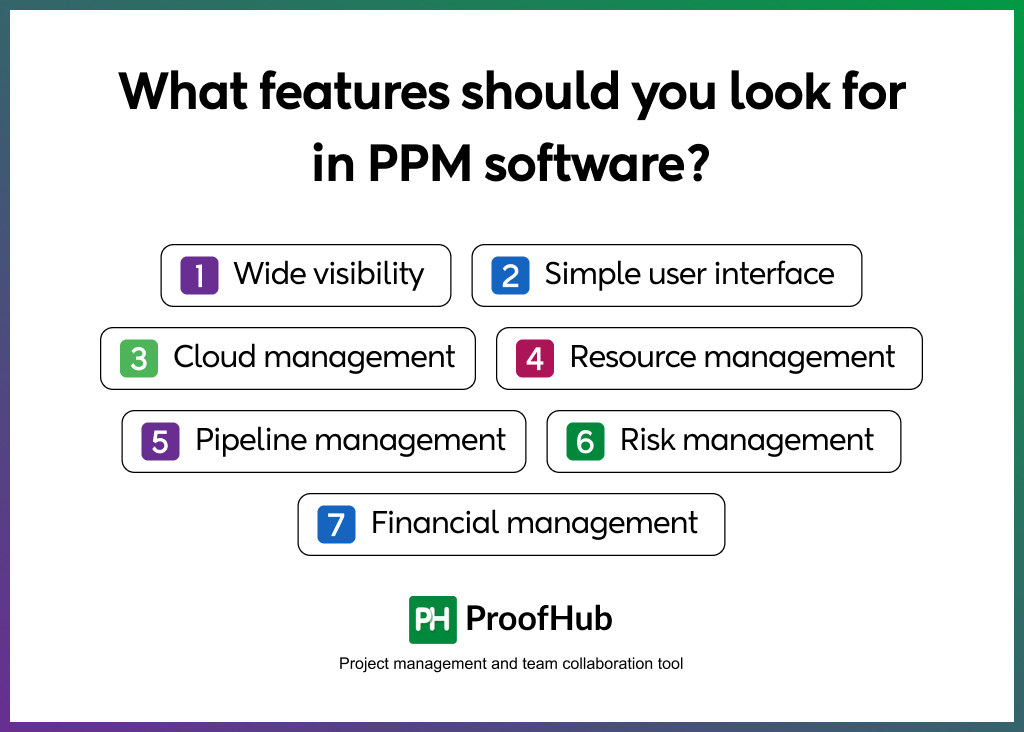
A project portfolio management software would assist you in the smooth progression of various projects in your organization. However, when choosing a PPM software, there are certain features that you must look out for. These features would help you identify the true potential of your team and smoothly manage project flow
1. Wide visibility
With wide visibility, you will be able to identify potential roadblocks early, distribute workload evenly among your team members, and minimize time spent acquiring knowledge and information.
2. Simple user interface
Having a simple user interface provides you with numerous advantages. This makes it easy for you to onboard team members. They can effectively use the tool to its complete potential with ease.
3. Cloud management
In this modern era, having software that runs on the cloud is necessary for the smooth operation of your business requirements. When you incorporate cloud-based software, your team members can work from remote locations.
This helps in simplifying the workflow and provides users with the ability to complete tasks on the go. Further, with quick access to data and information, your team members will be able to make decisions with confidence.
4. Resource management
Managing resources efficiently is important both for the successful completion of the project as well as for the continued scalability of the company.
PPM software should provide you with a transparent view of the resources and a transparent interaction with your team members, so you are able to have complete control over the performance of your team members.
5. Pipeline management
Managing the pre-project stage is critical for the success of any project. Selecting the right projects at the right time is essential for the continuous growth of the company.
PPM software helps you to decide between the number of initiated projects to the number of selected projects. Further, you will be able to identify projects that align with the vision of your company with ease.
6. Risk management
It is essential for you to have a complete understanding of the potential return and the value of the project.
An effective PPM software should be able to provide you with automated techniques for understanding the risk mitigation factor. This will help you to make effective decisions for incorporating effective risk response plans.
7. Financial management
A study revealed that only 59% of projects are completed within the allotted budget.
When using PPM software, you have central access to the performance of various projects in the past. This will help you to analyze and proceed accordingly in your upcoming project so that you are able to complete the project within time.
Conclusion
An effective PPM software will help your company with continuous growth and lining up projects for the continuous scalability of your company. This will help you to make data-driven decisions, and select which projects you must take up at what time.
ProofHub comes in as an all-in-one solution that helps you streamline all your projects – upcoming and in progress. This centralized dashboard eliminates the need for multiple tools and helps your team work on a single platform for better efficiency and seamless completion of projects on time. Try ProofHub today to experience streamlined project management and enhanced team collaboration like never before.
FAQs
What is the use of PPM tool?
A PPM tool basically solves the purpose of managing past as well as in-progress projects in a business. This tool helps you in aligning projects with the vision of the company and plays a key part in risk management, financial management, and resource allocation.
How does project portfolio management software work?
Project portfolio management software helps you to choose the right projects at the right time. Simply put, this software helps you streamline and schedule upcoming projects and seamlessly plan in-progress projects.
What are the three phases of project portfolio management?
The three phases of project portfolio management include
- Selection – the process of identifying and selecting projects that align with the overall vision of the company
- Execution – This involves planning, scheduling, and working on projects to ensure they fulfill the necessary objectives.
- Review – This is necessary for ensuring the overall performance of the project and the performance of various team members
What is the role of a project manager in PPM?
Project managers generally play a crucial role in PPM for planning, overseeing, and executing projects efficiently. The project managers are also responsible for defining project objectives, managing resources, and monitoring the overall progress and performance of the team members.
What are the three types of project portfolios?
The three types of project portfolios include –
- Strategic portfolio – for planning and building a roadmap for achieving the long-term objectives of the organization.
- Operational portfolio – for day-to-day support operation and managing the performance of various team members.
- Compliance portfolio – for legal and mandatory regulations that play a key role in compliance and risk management.
What is the difference between project management software and project portfolio management software?
The key difference between project management software and project portfolio management software is that project management software helps you do the project and get it completed. However, project portfolio management software helps you do the right projects at the right time.
